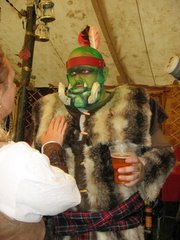Ok I know, I dont post as much as you would like, especial if your initials are JP....
Well, work progresses on the 10mm Old Glory
and the RSM95 figures have arrived, with a final payment to HMGovt of £30.91, bringing the grand total in at £166.10, or 57pence a figure, for what are really nice castes, next order will be for 10 bags of infantry and some mounted officers.
So now some reading has happened and the figures are infront of me.... i need to finalise my choice of Unit size and how i am gonna be basing the little fellows. The problem is when ever you ask an OSWargamer they only say "there is wrong way...... " which is al very liberating and also frustrating.
Overall Unit size is 48 troops and mounted Colonel with the Standards on a seperate Base
The Blue army will be 3 companys of 12 musketeers and a forth of 12 Grenadiers
The White army will be 3 companys of 16 musketeers
Cavalry will be in 4 figure squadrons
Artillery a single gun with 6 crew
Infantry 20mm square dividual bases Or 3 figures on a 50mmx25mm
Cavalry 50mmx25mm individual or multiple
Artillery 100mmx 100mm when deployed..... oh, Limbered..hmmm there is a thought
I like to use GW plastic Bases usually.... but i have doubts for this project
Ihavent written the rules yet, so that wont help
and i have just picked up Heroscape from Argos (£7.99) and the mechanichs are so simple they are almost Old School.....
So comment please, espcially if you can help.... my gut raction is to go for singles on the Infantry and pairs on the Cavalry
ox
Bagging the Hun First Edition Solo Focus
57 minutes ago

7 comments:
Okay, here is what I'm doing with my "Tricorne Wars" figures (also RSM95s by the way):
First, figures themselves will be mounted on washers or small steel plate.
Second, bases will have small neodymium magnets mounted in a "sandwich" of cardstock. These "rare earth" magnets are very powerful. The ones I'm using are about 1/4" wide disks (about 1.5mm thick) . . . and they are VERY powerful.
My battalions will be about half the size of yours -- six stands of four (two rows of two) and a "colour stand" used for showing the unit's cohesion.
With the magnets, casualties may be removed . . . and, if you want to try a different basing all you need to is to make new bases and then move the figures over to it.
You didn't say where you're located . . . but I'm guessing the UK (because of the mention of pounds). I'm in Western Canada.
-- Jeff
Duh . . . right, if I would only learn to read, I'd see that you are in London.
-- Jeff
For rules, you can of course write your own but you may also want to take a look at the Tricorn Wars set Jeff is working on, or at the BAR rules by Bill Protz of the OSW Yahoo Group. There's also an interesting set called Standing Like a Wall at www.wargames-etc.com which are SYW focused as well.
I'm leaning towards using BAR for my own rules, though my one played out game was with the SLaW rules.
Do you alreadu have some ideas about the uniforms of your two armies?
I suppose the 'white' army is that of austrian-based Skavenburg & the 'blue' that of prussian-based Saxe-Nweilintz?
Do you intend to use GW paints? A fellow blogger/ ImagiNation creator (http://davidsberg.blogspot.com/) used 'scorpion' green and 'tentacle' pink with great effect!
Shaun,
How are things progressing? You haven't posted in quite a while (almost two weeks).
-- Jeff
Basing.
Two schools of thought.
1) Single bases, this is normally used in 'skirmish' battles and has the advantage of being very flexible in allowing larger unit combinations to be put on a 'tray' in order that the troops all move together in their formations. The weakness lies in thier tendency to be 'knocked over' on the table (sometimes taking damage) and in the confusion over unit size/strength once casualties start being removed.
2) Combined bases. This format can take many forms, a typical one is 2-6 minis all stuck on one card or wooden base. The advantage is normally one of protection for the mini (the typical argument, but I have had more 'glued' minis damaged than 'loose' ones); another is a clear notation of unit strengths. A disadvantage is the inability to 'remove' casualties, so you need casualty caps or number markers or some other such thing.
A compromise is to 'hybrid' the two and have the bulk of a unit connected to 'stands' and have one stand that can be 'swapped' out. IE, if you have three men on a stand cut one free so that you have a '1' and '2' man stands, then whenever casualties result you can make them up with swapping out the '1' and '2' as needed.
For my minis I have decided to do away with such difficulties. All are mounted to metal fender washers and I have steel bases that I attach the minis to with neodymium magnets. 1 for infantry, 2 for cavalry and 3 for artillery guns and 'officer' stands. So far the only damage has been to one cavalry officer whos horse was attached to the ground by one leg!
This damage came about at the table in action and not when the entire tower of minis was knocked over 45 degrees, an incident that resulted in 0 damage since the minis were able to 'bend' and twist away from each other and move with the action of the case!
Post a Comment